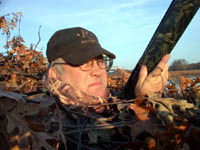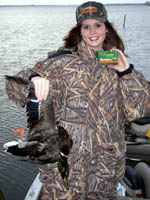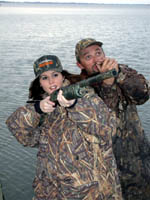
|
Features
|
|
|
|
Books
|
|
|
|
Fun & Games
|
|
|
|
Contact Us
|
|
|
John's Journal... Entry 178, Day 3
YO-YO DUCKS
Basic Duck-Hunting Tips
 EDITOR'S
NOTE: For more than 20 years Billy Blakely of Troy,
Tennessee, has guided duck hunters on Reelfoot Lake in Tiptonville, Tennessee.
Reelfoot Lake is 18,765 acres of water that was formed by a series of
earthquakes that started in December of 1811 and ended in February of
1812. At that time the Mississippi River flowed backwards and spilled
over into the hole left by the earthquakes, creating Reelfoot Lake. Loaded
with shallow-water flats, cypress swamps and plenty of shallow-water areas,
this lake homes ideal duck habitat. And to make this haven for duck hunters
even better, one state and two federal waterfowl refugees are located
around the lake. Another reason Reelfoot Lake has the most-dependable
duck hunting of any area I know in the United States is due to the yo-yo
effect this area experiences during waterfowl season. "When the weather
is cold, the ducks migrate from the North to Reelfoot," Blakely explains.
"When the weather turns hot, the ducks that travel north from Mississippi
and Louisiana also stop here. Reelfoot Lake seems to be the midpoint of
the two extremes of weather during waterfowl season." This week we'll
learn how Blakely and the other guides at Blue Bank Resort consistently
take ducks at this time of the year.
EDITOR'S
NOTE: For more than 20 years Billy Blakely of Troy,
Tennessee, has guided duck hunters on Reelfoot Lake in Tiptonville, Tennessee.
Reelfoot Lake is 18,765 acres of water that was formed by a series of
earthquakes that started in December of 1811 and ended in February of
1812. At that time the Mississippi River flowed backwards and spilled
over into the hole left by the earthquakes, creating Reelfoot Lake. Loaded
with shallow-water flats, cypress swamps and plenty of shallow-water areas,
this lake homes ideal duck habitat. And to make this haven for duck hunters
even better, one state and two federal waterfowl refugees are located
around the lake. Another reason Reelfoot Lake has the most-dependable
duck hunting of any area I know in the United States is due to the yo-yo
effect this area experiences during waterfowl season. "When the weather
is cold, the ducks migrate from the North to Reelfoot," Blakely explains.
"When the weather turns hot, the ducks that travel north from Mississippi
and Louisiana also stop here. Reelfoot Lake seems to be the midpoint of
the two extremes of weather during waterfowl season." This week we'll
learn how Blakely and the other guides at Blue Bank Resort consistently
take ducks at this time of the year.
 Question:
Billy, what gun do you prefer to use for waterfowling?
Question:
Billy, what gun do you prefer to use for waterfowling?
Blakely: I like the Remington 1187 because it's dependable. You can get
off three shots in a hurry with this shotgun, and it patterns very well.
Everyone has their own preference, but I like the Remington 1187.
Question: From what distance do you try and call ducks?
Blakely: On clear, sunny days I can call a duck into my blind that looks
like a pencil dot on a piece of paper. I call extremely loudly, and I
call an awful lot. I don't try to get the ducks' attention with my calling.
I try to hold their attention with loud, aggressive calling. I believe
this technique is what enables me to call in ducks that others won't even
attempt to call. I've learned that if you hit those high ducks with loud,
aggressive calling, and you don't continue to call them all the way into
the blind, those ducks will drop into someone else's decoys instead of
yours. When the ducks are within 50 to 60 yards of the blind, I'll ease
up on the calling and start giving them some feeding calls.
 Question:
What call do you give ducks when they're coming in?
Question:
What call do you give ducks when they're coming in?
Blakely: I start quacking to the ducks loudly and excitedly to finish
them off and put them directly in front of my hunters.
Question: How close do you get the ducks before you call
the shot?
Blakely: I want the ducks within 30 yards before I'll tell my hunters
to take the shot.
For more information on hunting at Reelfoot Lake, call the Blue Bank Resort at (731) 253-6878, visit www.bluebankresort.com, or write to Blue Bank at Route 1 Box 970, Tiptonville, TN 38079. Visit Remington's Website at www.remington.com to learn more about the company's high-quality guns, or call (800) 243-9700.
Check back each day this week for more about YO-YO DUCKS ...
Day 1 - Decoys and Blinds
Day 2 - Calls, Shells and Spreads
Day 3 - Basic Duck-Hunting Tips
Day 4 - Best Days of Duck Hunting
Day 5 - Open-Water Hunts